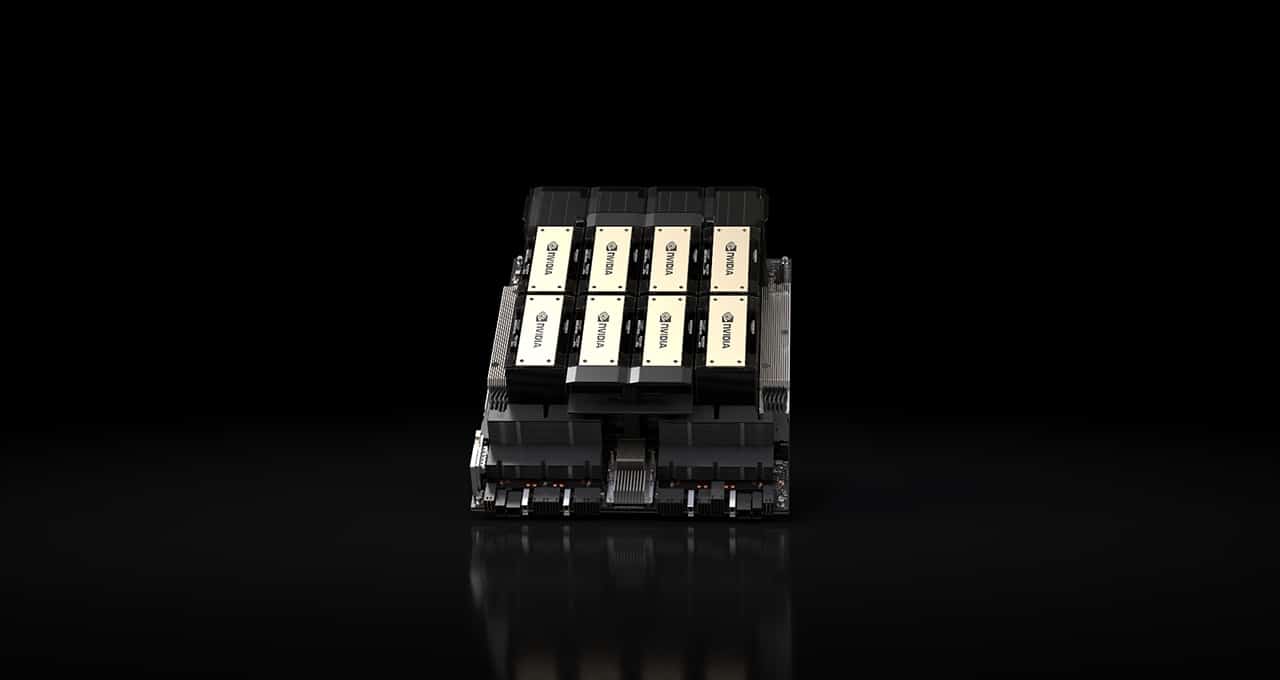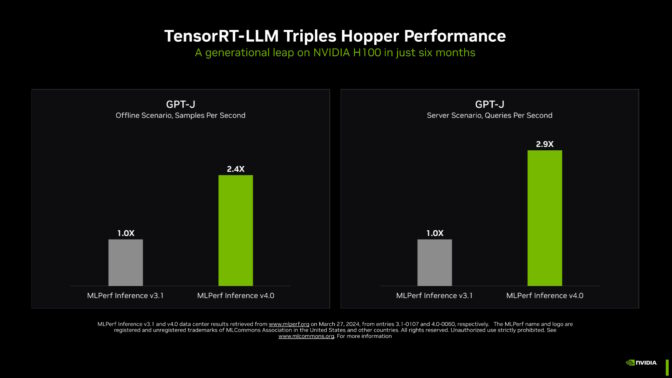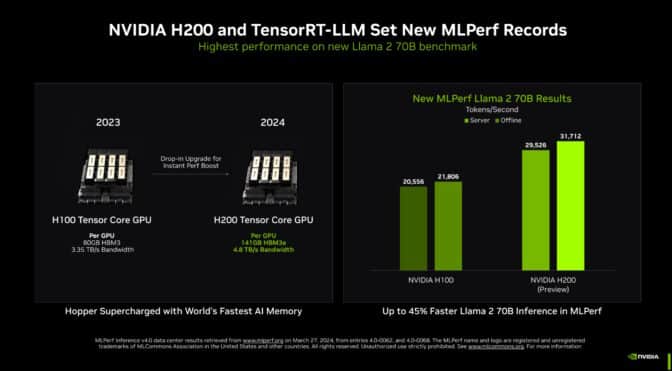[ad_1]
It’s official: NVIDIA delivered the world’s quickest platform in industry-standard checks for inference on generative AI.
Within the newest MLPerf benchmarks, NVIDIA TensorRT-LLM — software program that speeds and simplifies the advanced job of inference on giant language fashions — boosted the efficiency of NVIDIA Hopper structure GPUs on the GPT-J LLM practically 3x over their outcomes simply six months in the past.
The dramatic speedup demonstrates the facility of NVIDIA’s full-stack platform of chips, methods and software program to deal with the demanding necessities of working generative AI.
Main firms are utilizing TensorRT-LLM to optimize their fashions. And NVIDIA NIM — a set of inference microservices that features inferencing engines like TensorRT-LLM — makes it simpler than ever for companies to deploy NVIDIA’s inference platform.
Elevating the Bar in Generative AI
TensorRT-LLM working on NVIDIA H200 Tensor Core GPUs — the most recent, memory-enhanced Hopper GPUs — delivered the quickest efficiency working inference in MLPerf’s greatest take a look at of generative AI to this point.
The brand new benchmark makes use of the biggest model of Llama 2, a state-of-the-art giant language mannequin packing 70 billion parameters. The mannequin is greater than 10x bigger than the GPT-J LLM first used within the September benchmarks.
The memory-enhanced H200 GPUs, of their MLPerf debut, used TensorRT-LLM to provide as much as 31,000 tokens/second, a report on MLPerf’s Llama 2 benchmark.
The H200 GPU outcomes embrace as much as 14% features from a customized thermal resolution. It’s one instance of improvements past commonplace air cooling that methods builders are making use of to their NVIDIA MGX designs to take the efficiency of Hopper GPUs to new heights.
Reminiscence Increase for NVIDIA Hopper GPUs
NVIDIA is sampling H200 GPUs to clients as we speak and transport within the second quarter. They’ll be out there quickly from practically 20 main system builders and cloud service suppliers.
H200 GPUs pack 141GB of HBM3e working at 4.8TB/s. That’s 76% extra reminiscence flying 43% sooner in comparison with H100 GPUs. These accelerators plug into the identical boards and methods and use the identical software program as H100 GPUs.
With HBM3e reminiscence, a single H200 GPU can run a complete Llama 2 70B mannequin with the best throughput, simplifying and rushing inference.
GH200 Packs Even Extra Reminiscence
Much more reminiscence — as much as 624GB of quick reminiscence, together with 144GB of HBM3e — is packed in NVIDIA GH200 Superchips, which mix on one module a Hopper structure GPU and a power-efficient NVIDIA Grace CPU. NVIDIA accelerators are the primary to make use of HBM3e reminiscence expertise.
With practically 5 TB/second reminiscence bandwidth, GH200 Superchips delivered standout efficiency, together with on memory-intensive MLPerf checks reminiscent of recommender methods.
Sweeping Each MLPerf Take a look at
On a per-accelerator foundation, Hopper GPUs swept each take a look at of AI inference within the newest spherical of the MLPerf {industry} benchmarks.
The benchmarks cowl as we speak’s hottest AI workloads and situations, together with generative AI, advice methods, pure language processing, speech and laptop imaginative and prescient. NVIDIA was the one firm to submit outcomes on each workload within the newest spherical and each spherical since MLPerf’s knowledge heart inference benchmarks started in October 2020.
Continued efficiency features translate into decrease prices for inference, a big and rising a part of the each day work for the hundreds of thousands of NVIDIA GPUs deployed worldwide.
Advancing What’s Doable
Pushing the boundaries of what’s doable, NVIDIA demonstrated three revolutionary methods in a particular part of the benchmarks referred to as the open division, created for testing superior AI strategies.
NVIDIA engineers used a method referred to as structured sparsity — a manner of lowering calculations, first launched with NVIDIA A100 Tensor Core GPUs — to ship as much as 33% speedups on inference with Llama 2.
A second open division take a look at discovered inference speedups of as much as 40% utilizing pruning, a manner of simplifying an AI mannequin — on this case, an LLM — to extend inference throughput.
Lastly, an optimization referred to as DeepCache decreased the maths required for inference with the Steady Diffusion XL mannequin, accelerating efficiency by a whopping 74%.
All these outcomes had been run on NVIDIA H100 Tensor Core GPUs.
A Trusted Supply for Customers
MLPerf’s checks are clear and goal, so customers can depend on the outcomes to make knowledgeable shopping for choices.
NVIDIA’s companions take part in MLPerf as a result of they realize it’s a precious device for patrons evaluating AI methods and providers. Companions submitting outcomes on the NVIDIA AI platform on this spherical included ASUS, Cisco, Dell Applied sciences, Fujitsu, GIGABYTE, Google, Hewlett Packard Enterprise, Lenovo, Microsoft Azure, Oracle, QCT, Supermicro, VMware (not too long ago acquired by Broadcom) and Wiwynn.
All of the software program NVIDIA used within the checks is accessible within the MLPerf repository. These optimizations are constantly folded into containers out there on NGC, NVIDIA’s software program hub for GPU purposes, in addition to NVIDIA AI Enterprise — a safe, supported platform that features NIM inference microservices.
The Subsequent Huge Factor
The use circumstances, mannequin sizes and datasets for generative AI proceed to increase. That’s why MLPerf continues to evolve, including real-world checks with fashionable fashions like Llama 2 70B and Steady Diffusion XL.
Preserving tempo with the explosion in LLM mannequin sizes, NVIDIA founder and CEO Jensen Huang introduced final week at GTC that the NVIDIA Blackwell structure GPUs will ship new ranges of efficiency required for the multitrillion-parameter AI fashions.
Inference for giant language fashions is tough, requiring each experience and the full-stack structure NVIDIA demonstrated on MLPerf with Hopper structure GPUs and TensorRT-LLM. There’s way more to return.
Be taught extra about MLPerf benchmarks and the technical particulars of this inference spherical.
[ad_2]



